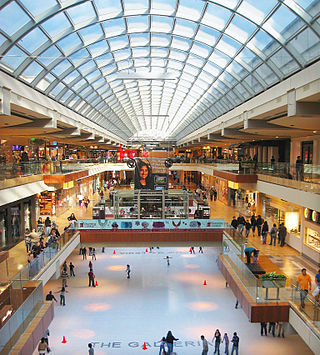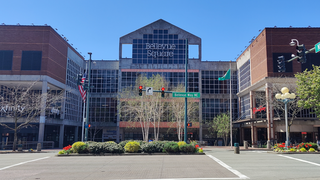
Nordstrom, Inc. is an American luxury department store chain headquartered in Seattle, Washington, and founded by John W. Nordstrom and Carl F. Wallin in 1901. The original Wallin & Nordstrom store operated exclusively as a shoe store, and a second Nordstrom's shoe store opened in 1923. The growing Nordstrom Best chain began selling clothing in 1963, and became the Nordstrom full-line retailer that presently exists by 1971. The company founded its off-price Nordstrom Rack division in 1973, and grew both full-line and off-price divisions throughout the United States in the following years. The full-line division competes with department stores including Bloomingdale's, Macy's, Neiman Marcus, and Saks Fifth Avenue, while the off-price division competes with retailers including the TJX Companies and Ross Stores. Previous expansions beyond the contiguous United States include Puerto Rico (2015–2020) and Canada (2014–2023).

A department store is a retail establishment offering a wide range of consumer goods in different areas of the store, each area ("department") specializing in a product category. In modern major cities, the department store made a dramatic appearance in the middle of the 19th century, and permanently reshaped shopping habits, and the definition of service and luxury. Similar developments were under way in London, in Paris and in New York City (Stewart's).

Macy's is an American department store chain founded in 1858 by Rowland Hussey Macy. It has been a sister brand to the Bloomingdale's department store chain since being acquired by holding company Federated Department Stores in 1994, which renamed itself Macy's, Inc. in 2007. It is the largest department store company by retail sales in the United States as of 2023.

The Galleria, stylized theGalleria and also known as the Houston Galleria, is an upscale mixed-use urban development and shopping mall located in the Uptown District of Houston, Texas, United States. The development consists of a retail complex, as well as the Galleria Office Towers complex, two Westin hotels, and a private health club. The office towers and hotels are separately owned and managed from the mall. It features Macy's, Nordstrom, Neiman Marcus, and Saks Fifth Avenue.
Marshall Field & Company was an upscale department store in Chicago, Illinois. Founded in the 19th century, it grew to become a large chain before Macy's, Inc, acquired it in 2005. Its founder, Marshall Field, was a pioneering retail magnate.
The J. L. Hudson Company was an upscale retail department store chain based in Detroit, Michigan. Hudson's flagship store, on Woodward Avenue in Downtown Detroit, was the tallest department store in the world in 1961, and, at one time, claimed to be the second-largest department store, after Macy's, in the United States, by square footage.

Gimbel Brothers was an American department store corporation that operated for over a century, from 1842 until 1987. Gimbel patriarch Adam Gimbel opened his first store in Vincennes, Indiana, in 1842. In 1887, the company moved its operations to the Gimbel Brothers Department Store in Milwaukee, Wisconsin. It became a chain when it opened a second, larger store in Philadelphia, Pennsylvania, in 1894, moving its headquarters there. At the urging of future company president Bernard Gimbel, grandson of the founder, the company expanded to New York City in 1910.

Del Amo Fashion Center is a three-level regional shopping mall in Torrance, California, United States. It is currently managed and co-owned by Simon Property Group.

Bellevue Square is a shopping center in Bellevue, Washington. The mall has over 200 retail stores with anchors Macy's and Nordstrom. Bellevue Square also offers concierge services, valet parking, and a children's play area. It and the connecting Lincoln Square comprise The Bellevue Collection.

Meier & Frank was a prominent chain of department stores founded in Portland, Oregon, United States, and later bought by The May Department Stores Company. Meier & Frank operated in the Pacific Northwest from 1857 to 2006.

Lloyd Center is a shopping mall in the Lloyd District of Portland, Oregon, United States, just northeast of downtown. It is owned by the Urban Renaissance Group and KKR Real Estate Finance Trust Inc. The mall features three floors of shopping, with the third level serving mostly as professional office spaces, a food court, and U.S. Education Corporation's Carrington College. Lloyd Center also includes the Lloyd Center Ice Skating Rink, which has become the main draw for the mall. There are currently no anchors in the mall. There are vacant anchor spaces left by Macy's, Marshalls, Nordstrom, and Sears. Junior anchors include Barnes & Noble and Ross Dress for Less.

Frango mints are a brand of chocolate truffles first created for the Frederick & Nelson department stores. Traditionally flavored with mint and widely popularized by the Marshall Field and Company department store, they were later produced and distributed by Macy's department stores. Frango is also the brand name of a line of various other related food products.

Lipman's was an American department store chain based in Portland, Oregon. Founded in 1850 in Sacramento, California, the company was originally known as the Lipman–Wolfe & Company, named after the two founding partners: Adolphe Wolfe and his uncle, Soloman Lipman. It eventually grew to six stores in Oregon before they were rebranded to Frederick & Nelson in 1979. The 1912 building in downtown Portland that was the company's flagship store is listed on the National Register of Historic Places, as the Lipman–Wolfe and Company Building.

TJ Maxx is an American discount department store chain. It has more than 1,000 stores in the United States, making it one of the largest clothing retailers in the country. TJ Maxx is the flagship chain of the TJX Companies. It sells men's, women's and children's apparel and shoes, toys, bath and beauty products, accessories, jewelry, and home products ranging from furniture and decor to housewares and kitchen utensils.

British American Tobacco US, mostly known for its acronym BATUS, was the United States subsidiary of multinational company British American Tobacco (BAT), the world's second largest cigarette manufacturer. BATUS served as the U.S. holding company for BAT. In the 1960s, the company diversified into areas such as insurance, drink, and retail.

Westlake Center is a four-story shopping center and 25-story office tower in downtown Seattle, Washington, United States. The southern terminus of the Seattle Center Monorail, it is located across Pine Street from Westlake Park, between 4th and 5th Avenues. It is named for Westlake Avenue, which now terminates north of the mall but once ran two blocks farther south to Pike Street. Westlake Park is considered Seattle's "town square" and celebrities and political figures often make appearances or give speeches from the building's balcony. The anchor stores are Saks Off 5th and Nordstrom Rack.

Towson Town Center is a large indoor shopping mall located in Towson, Maryland. It was the largest indoor shopping mall in Maryland prior to the completion of Arundel Mills in late 2000 in Hanover and the 2007 expansion of Westfield Annapolis.

The Crescent was a small chain of department stores founded and based in Spokane, Washington. Once a subsidiary of Marshall Field & Company, the chain was sold to BATUS Retail Group in 1982. BATUS renamed the stores Frederick & Nelson, the company's Seattle, Washington division, in 1988. Frederick and Nelson eventually filed for bankruptcy and liquidated in 1992. At its peak, The Crescent operated seven department stores in Washington and Oregon, including three in Spokane.
Valu-Mart was a chain of discount stores founded in Seattle in 1958. Its parent company was Weisfield's Jewelers. For many years Weisfield's was a store that carried jewelry, as well as televisions, radios, stereos, and other consumer electronics products. Once Valu-Mart was put into place, Weisfield's strictly became a jewelry store. The chain also had stores in Oregon, where they originally were named Villa-Mart. Separate grocery sections in the stores featured curbside grocery pickup by placing the grocery bags into numbered bins that rolled onto a conveyor allowing the customer to drive up to the front of the store to pick them up by giving the attendant a plastic card with the numbered bin they used. The groceries were then loaded into the car usually by store employees.

The Marshall Field and Company Building is a National Historic Landmark retail building on State Street in Chicago, Illinois. Now housing Macy's State Street, the Beaux-Arts and Commercial style complex was designed by architect Daniel Burnham and built in two stages—north end in 1901–02 and south end in 1905–06. It was the flagship location of the Marshall Field and Company and headquarters Marshall Field's chain of department stores. Since 2006, it is the main Chicago and midwestern location of the Macy's department stores. The building is located in the Chicago Loop area of the downtown central business district and it takes up the entire city block bounded clockwise from the west by North State Street, East Randolph Street, North Wabash Avenue, and East Washington Street. Field and partners founded their Chicago store in 1852, and first built an expansive shopping emporium on this site in 1868. The 1901 building was the fourth for the department store at this site.





















